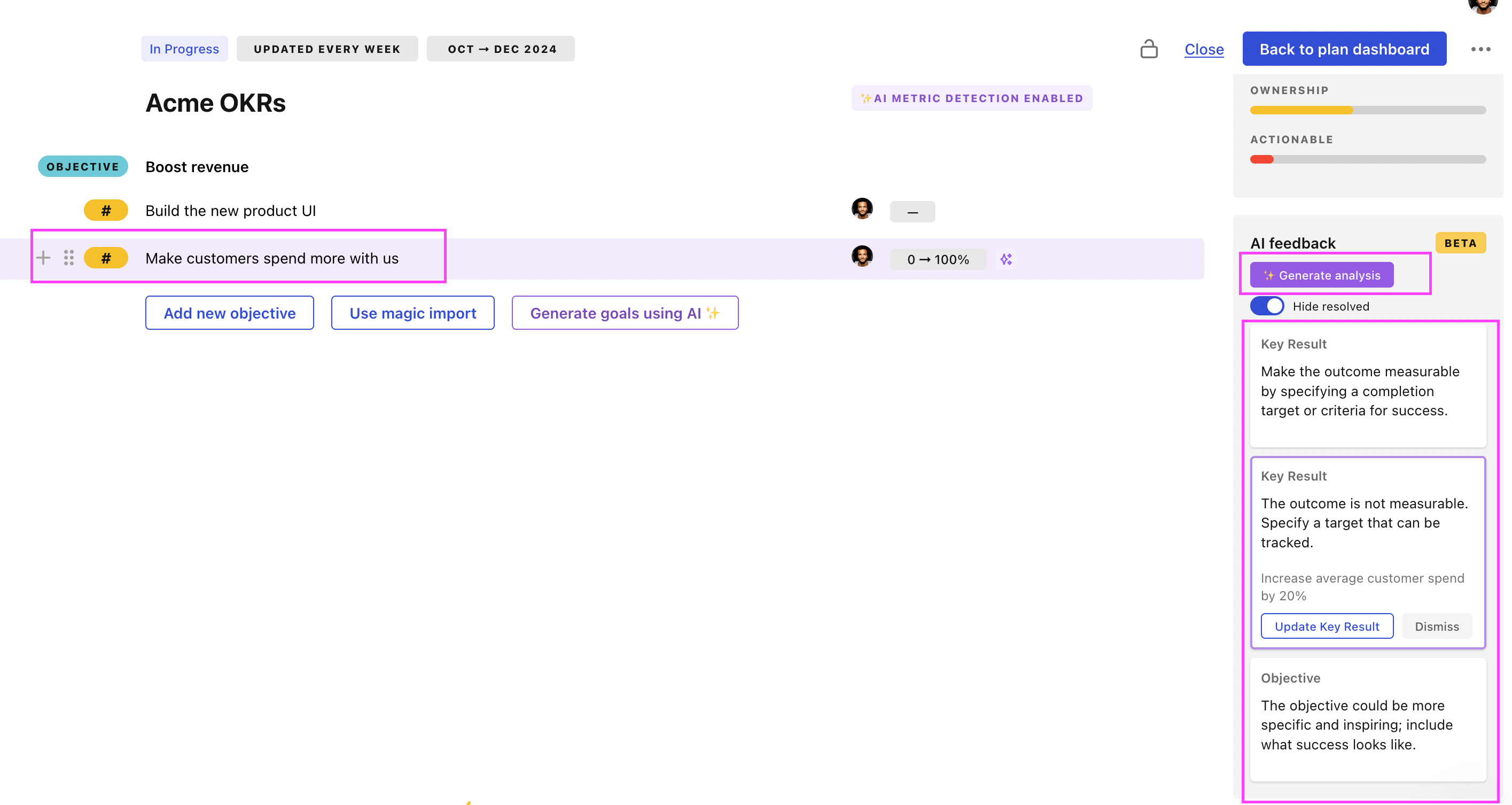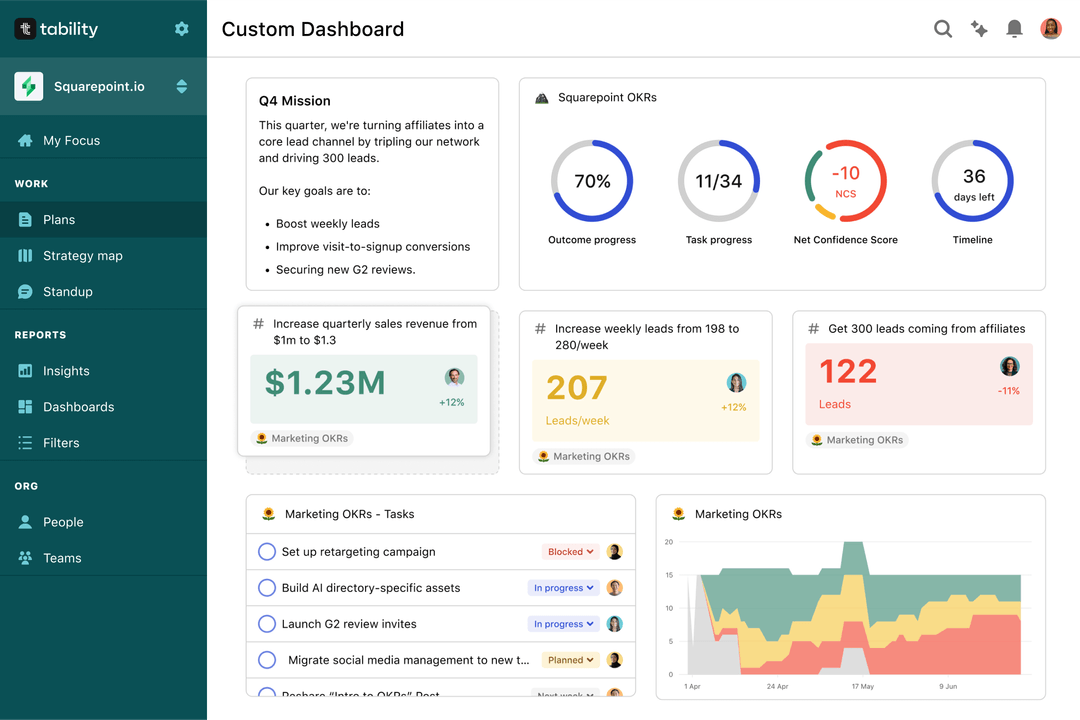Tability is a cheatcode for goal-driven teams. Set perfect OKRs with AI, stay focused on the work that matters.
What are Performance Audit Team OKRs?
The Objective and Key Results (OKR) framework is a simple goal-setting methodology that was introduced at Intel by Andy Grove in the 70s. It became popular after John Doerr introduced it to Google in the 90s, and it's now used by teams of all sizes to set and track ambitious goals at scale.
Crafting effective OKRs can be challenging, particularly for beginners. Emphasizing outcomes rather than projects should be the core of your planning.
We have a collection of OKRs examples for Performance Audit Team to give you some inspiration. You can use any of the templates below as a starting point for your OKRs.
If you want to learn more about the framework, you can read our OKR guide online.
The best tools for writing perfect Performance Audit Team OKRs
Here are 2 tools that can help you draft your OKRs in no time.
Tability AI: to generate OKRs based on a prompt
Tability AI allows you to describe your goals in a prompt, and generate a fully editable OKR template in seconds.
- 1. Create a Tability account
- 2. Click on the Generate goals using AI
- 3. Describe your goals in a prompt
- 4. Get your fully editable OKR template
- 5. Publish to start tracking progress and get automated OKR dashboards
Watch the video below to see it in action 👇
Tability Feedback: to improve existing OKRs
You can use Tability's AI feedback to improve your OKRs if you already have existing goals.
- 1. Create your Tability account
- 2. Add your existing OKRs (you can import them from a spreadsheet)
- 3. Click on Generate analysis
- 4. Review the suggestions and decide to accept or dismiss them
- 5. Publish to start tracking progress and get automated OKR dashboards

Tability will scan your OKRs and offer different suggestions to improve them. This can range from a small rewrite of a statement to make it clearer to a complete rewrite of the entire OKR.
Performance Audit Team OKRs examples
You will find in the next section many different Performance Audit Team Objectives and Key Results. We've included strategic initiatives in our templates to give you a better idea of the different between the key results (how we measure progress), and the initiatives (what we do to achieve the results).
Hope you'll find this helpful!
OKRs to enhance website for increased Conversion Rate Optimization (CRO)
ObjectiveEnhance website for increased Conversion Rate Optimization (CRO)
KRIncrease CTA responsiveness by redesigning 20% of web pages for better engagement
Identify engagement elements for redesign
Implement and test website changes
Analyze current webpage design for needed improvements
KRImprove site load speed by 30% to reduce bounce rates
Conduct a performance audit on website elements
Optimize images and streamline design elements
Implement a reliable Content Delivery Network (CDN)
KRImplement A/B testing on 50% of landing pages to boost conversion rates
Monitor and analyze test results for conversion improvements
Develop different versions for selected pages
Identify 50% of landing pages for A/B testing
OKRs to accelerate revenue growth, enhance scalability, and boost client satisfaction
ObjectiveAccelerate revenue growth, enhance scalability, and boost client satisfaction
KRImprove system efficiency by 20% to support increased customer base without extra costs
Implement optimization strategies for identified system inefficiencies
Identify system bottlenecks through comprehensive performance audits
Regularly monitor system performance to ensure continued efficiency
KRAchieve at least a 90% satisfaction rating from existing clients via quality service
Address client complaints quickly and effectively
Implement regular satisfaction surveys for continuous feedback
Improve customer service training for all front-line staff members
KRExpand market share by 15% through strategic partnerships and product innovation
Negotiate and formalize partnership agreements
Identify potential strategic partners in target market areas
Develop innovative, consumer-driven product enhancements
Performance Audit Team OKR best practices
Generally speaking, your objectives should be ambitious yet achievable, and your key results should be measurable and time-bound (using the SMART framework can be helpful). It is also recommended to list strategic initiatives under your key results, as it'll help you avoid the common mistake of listing projects in your KRs.
Here are a couple of best practices extracted from our OKR implementation guide 👇
Tip #1: Limit the number of key results
The #1 role of OKRs is to help you and your team focus on what really matters. Business-as-usual activities will still be happening, but you do not need to track your entire roadmap in the OKRs.
We recommend having 3-4 objectives, and 3-4 key results per objective. A platform like Tability can run audits on your data to help you identify the plans that have too many goals.
Tip #2: Commit to weekly OKR check-ins
Don't fall into the set-and-forget trap. It is important to adopt a weekly check-in process to get the full value of your OKRs and make your strategy agile – otherwise this is nothing more than a reporting exercise.
Being able to see trends for your key results will also keep yourself honest.
Tip #3: No more than 2 yellow statuses in a row
Yes, this is another tip for goal-tracking instead of goal-setting (but you'll get plenty of OKR examples above). But, once you have your goals defined, it will be your ability to keep the right sense of urgency that will make the difference.
As a rule of thumb, it's best to avoid having more than 2 yellow/at risk statuses in a row.
Make a call on the 3rd update. You should be either back on track, or off track. This sounds harsh but it's the best way to signal risks early enough to fix things.
Save hours with automated Performance Audit Team OKR dashboards

Quarterly OKRs should have weekly updates to get all the benefits from the framework. Reviewing progress periodically has several advantages:
- It brings the goals back to the top of the mind
- It will highlight poorly set OKRs
- It will surface execution risks
- It improves transparency and accountability
Spreadsheets are enough to get started. Then, once you need to scale you can use Tability to save time with automated OKR dashboards, data connectors, and actionable insights.
How to get Tability dashboards:
- 1. Create a Tability account
- 2. Use the importers to add your OKRs (works with any spreadsheet or doc)
- 3. Publish your OKR plan
That's it! Tability will instantly get access to 10+ dashboards to monitor progress, visualise trends, and identify risks early.
More Performance Audit Team OKR templates
We have more templates to help you draft your team goals and OKRs.
OKRs to minimize fraudulent transactions on debit cards
OKRs to enhance problem-solving proficiency in water treatment
OKRs to publish a high-value social impact report
OKRs to increase revenue through add-ons and seamless integrations
OKRs to enhance customer experience in purchasing and selling journey
OKRs to to expand my understanding of royalties